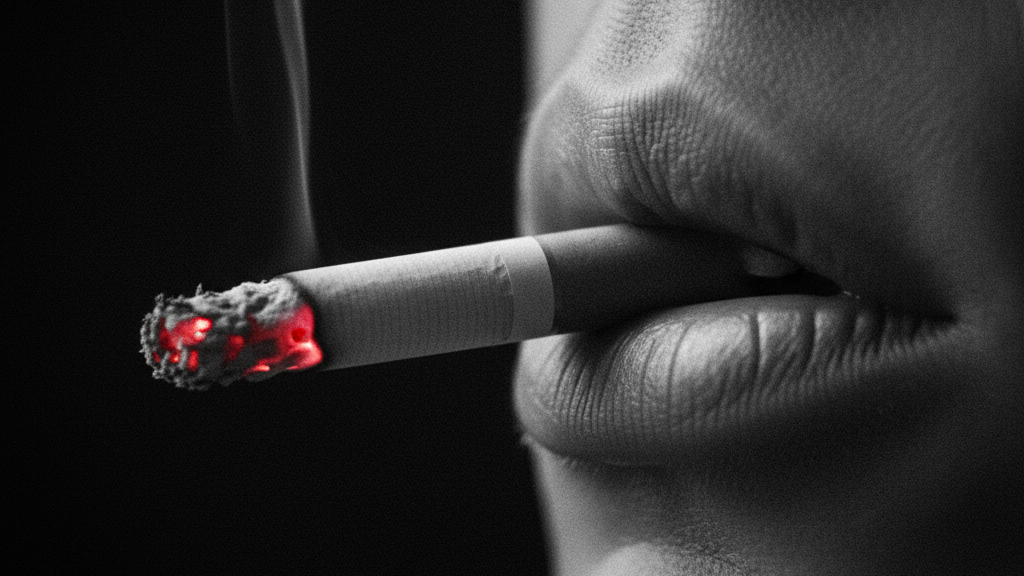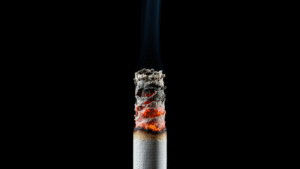In plain terms, cigarettes are made of processed tobacco, paper with burn additives, a plastic-based filter, and extra additives or flavors. Once lit, the mix turns into smoke carrying thousands of chemicals, including dozens that can cause cancer.
What Are The Ingredients In Cigarettes?
At a high level, what the ingredients in cigarettes come down to four basics: tobacco, paper, a filter, and additives. Below is how each part is built and why it matters once you light it up.
Tobacco And Processing
At the core is cured and blended tobacco. Manufacturers mix leaf types to hit a specific nicotine level, “body,” and flavor. The leaf itself contains nicotine naturally. Processing also adds humectants (to keep tobacco moist) and flavors (like menthol) that alter taste and harshness. This base—before burning—sets up the chemistry you eventually inhale.
Paper And Burn Additives
Cigarette paper isn’t neutral. It’s engineered to control burn rate and ash, and often includes compounds that help the cigarette keep burning between puffs. The design affects how hot the tobacco burns and how smoke is delivered, which influences what ends up in your lungs and the air around you.
Filters And Plastics
Most filters are made from cellulose acetate, a plastic fiber bundled into a white plug. Additives like triacetin act as a plasticizer to hold fibers together. Filters can trap some larger particles, but don’t remove most toxic gases; they also change how people puff. Public-health research shows they don’t make smoking safe and have their own environmental downsides such as plastic litter.
Additives And Flavorings
Additives cover a long list—flavorings (menthol, cocoa, licorice), humectants (glycerol, propylene glycol), and processing aids. The FDA maintains a list of 93 harmful and potentially harmful constituents (HPHCs) that regulators track in tobacco and smoke, underscoring that a “recipe” can include substances tied to cancer, heart, and lung disease.
The physical ingredients are simple to name but complicated in effect. Paper, filter, and additives change how tobacco burns and how toxic chemicals form and reach the smoker.
What Are The Ingredients In Cigarettes And What Happens When They Burn?
Knowing what the ingredients in cigarettes are is only the first step; fire changes everything. The notes below show how heat creates new chemicals and why both mainstream and sidestream smoke matter.
Pyrolysis And Incomplete Combustion Products
Lighting a cigarette drives the temperature in the burning cone to hundreds of degrees Celsius. That heat pyrolyzes (chemically breaks down) tobacco and additives, creating new compounds. The smoke from a typical cigarette contains more than 7,000 chemicals, with about 70 known to cause cancer—illustrating how burning turns a short ingredient list into a vast chemical soup.
Main Harmful And Potentially Harmful Constituents
Key offenders include nicotine (addictive), carbon monoxide (reduces oxygen delivery), formaldehyde, benzene, acrolein, tobacco-specific nitrosamines, and toxic metals like cadmium and lead. These appear on the FDA’s HPHC list because they’re tied to cancer, cardiovascular harm, respiratory disease, reproductive risks, or addiction.
Mainstream Vs. Sidestream Smoke
Mainstream smoke is what a smoker inhales and exhales; sidestream smoke comes off the lit tip between puffs. Secondhand smoke is a mix of both and carries many of the same toxic, cancer-causing chemicals. There is no safe level of exposure for people nearby.
The “ingredients” change dramatically after ignition. Burning multiplies the chemical count and pushes dangerous gases and particles into both mainstream and secondhand smoke.
What Are The Ingredients In Cigarettes And How Do They Affect Health?
Here’s how the ingredient mix—and the smoke it produces—translates into disease. If you wonder whether what are the ingredients in cigarettes truly matter, this is where the impact shows up.
Carcinogens And Toxic Metals
Dozens of smoke chemicals are carcinogens. Long-term exposure damages DNA and can lead to cancers in the lung, throat, mouth, bladder, and more. Toxic metals—cadmium, lead—accumulate in the body and add to the risk profile. The CDC estimates U.S. smoking and secondhand smoke together contribute to hundreds of thousands of deaths annually.
Cardiovascular And Respiratory Toxicants
Gases like carbon monoxide and irritants such as acrolein harm the heart and lungs. They promote plaque buildup, trigger inflammation, and narrow airways, raising risks for heart attack, stroke, COPD, and asthma flares. These effects are not fixed by switching brands or using “light” or “low-tar” varieties.
Reproductive And Developmental Risks
Nicotine and other constituents can affect fertility, pregnancy outcomes, and fetal development. Secondhand exposure also raises risks for children and adults who don’t smoke, including higher odds of lung cancer and heart disease; the CDC notes 7,300+ lung-cancer deaths among nonsmokers each year in the U.S. due to secondhand smoke.
Whether you smoke or breathe someone else’s smoke, the chemical mix produced by burning tobacco drives cancer, heart disease, and lung disease. The health burden is wide and well-documented across major public-health agencies.

What Are The Ingredients In Cigarettes And How Can You Reduce Exposure?
If you’re asking what the ingredients are in cigarettes, the next question is how to cut your contact with them. The steps below focus on actions that actually move the needle.
Cessation Strategies And Evidence-Based Support
The most reliable way to cut exposure is to quit completely. Evidence-based tools include counseling, quitlines, and FDA-approved medications (nicotine replacement therapy, bupropion, varenicline). Combining behavioral support with medication roughly doubles the odds of success compared with willpower alone, and the health benefits begin quickly. (Check your state quitline or healthcare provider.)
Filter Myths And Practical Limitations
Filters—especially ventilated ones—do not reliably lower disease risk. They can encourage deeper or more frequent puffs to maintain nicotine intake, leaving exposure the same or worse. Public-health reviews argue that filtered products may mislead smokers about safety and add plastic pollution. Don’t rely on filters to make smoking “safer.”
Harm Reduction Options And Precautions
For people not ready to quit today, reducing daily cigarette count and strict smoke-free home/car rules lower exposure for family members. Keep in mind: switching brands or “styles” isn’t meaningful harm reduction; only total smoke exposure matters. Talk with a clinician about a quit plan that fits your situation and timeline.
Real risk reduction focuses on quitting, protecting others from secondhand smoke, and avoiding false comfort from filters or brand switches. Help is available, and progress counts.
FAQ
Q1. What Are The Ingredients In Cigarettes That Make Them Addictive, And Why Is Quitting So Hard?
Nicotine is a natural chemical in tobacco that reaches the brain within seconds and triggers dopamine release—your brain’s reward signal. Over time, your body adapts, so the same cigarette feels less satisfying, and withdrawal (irritability, cravings, poor sleep) kicks in when levels drop. Paper, filters, and flavors don’t cause the addiction, but they change how smoke feels and how people puff, which can reinforce the habit. Medications and counseling target both withdrawal and habits, making quitting far more manageable than going “cold turkey.”
Q2. What Are The Ingredients In Cigarette Filters, And Do They Actually Protect Me?
Filters are mostly cellulose acetate plastic, often held together with triacetin. They change the draw resistance and can trap some particles, but most toxic gases and many fine particles still pass through. People tend to compensate—taking longer, deeper puffs to get nicotine—so real-world exposure doesn’t reliably fall. Public-health experts and recent reviews argue filters may create a false sense of safety and add plastic waste. Bottom line: a filter doesn’t turn a hazardous product into a safe one.
Q3. What Are The Ingredients In Cigarettes Paper, And Do Burn Additives Matter For Secondhand Smoke?
Cigarette paper is engineered with burn modifiers so the rod lights easily and keeps burning. That design influences temperature and oxygen levels at the burning tip and, in turn, the chemistry of both mainstream and sidestream smoke. Because sidestream smoke comes directly off the lit tip, people nearby inhale many of the same cancer-causing substances even if they don’t smoke themselves. There’s no safe level of secondhand exposure; keeping indoor spaces 100% smoke-free is the only reliable protection.
Conclusion
Ready to act on what you’ve learned about the ingredients in cigarettes? Call your state quitline or talk to a clinician today, set a quit date, and make every indoor space smoke-free. Your lungs—and everyone around you—will notice fast.




